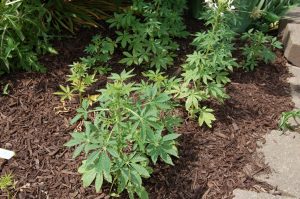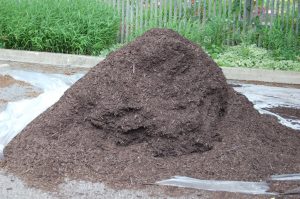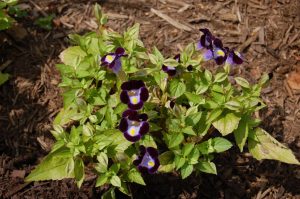Although the benefits of mulching garden plants are many, wood mulch that has been improperly stockpiled can lead to plant injury or even death. Young herbaceous plants are the most susceptible to such injury, which becomes obvious shortly after applying a hardwood bark mulch. Plants may look like they have been burned with fertilizer or pesticides, or possibly, are under severe water stress. All of the above could potentially be a problem, but apparently, we must now add “sour mulch” to the list of suspects.
When hardwood bark mulch is stacked in tall piles and allowed to stand for long periods, the material in the center of the pile begins to compost anaerobically (without air) and may sour. The term “sour” refers to the extreme acidity that occurs under such conditions (reported to be pH of 1.8-3.6, while that of “normal” mulch is generally close to 7.0). Some reports indicate that pine bark does not sour.
The mulch tends to heat as it breaks down, and steam may be seen escaping from the pile when it is finally disturbed. This heat can directly injure plants, if the mulch is not allowed to cool first. However, the more serious problem is that anaerobic composting of hardwood leads to the production of several plant-damaging components; methane, alcohol, ammonia and hydrogen sulfide are possibilities.
Injury to young, tender plants is swift, usually within one day of applying mulch. Symptoms include yellowing or blackening of foliage and leaf drop. Depending on the extent of the injury, plants often are able to recover. Thorough watering, especially during hot, dry weather, will help prevent further stress. Do not apply fertilizer to plants injured by sour mulch; such materials can cause further injury. However, if plants recover yet seem to be lacking in vigor, a side dressing of nitrogen may be helpful in mid-summer if weather conditions warrant. Avoid fertilizing during hot, dry weather.
The best course of action is to prevent sour mulch injury in the first place. Stockpiles should be no higher than 4 feet, if possible; if it’s necessary to stack taller, turn them periodically to allow some aeration. Alternatively, sour mulch can be made fit for use by spreading in shallow layers and allowing it to air out for a few days, preferably a week, before using around young, tender plants. If no rainfall has occurred, watering the mulch also may help wash away toxic accumulations.


